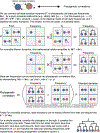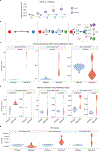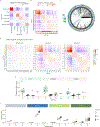Defining heritability, plasticity, and transition dynamics of cellular phenotypes in somatic evolution
- PMID: 39317739
- PMCID: PMC11527590
- DOI: 10.1038/s41588-024-01920-6
Defining heritability, plasticity, and transition dynamics of cellular phenotypes in somatic evolution
Abstract
Single-cell sequencing has characterized cell state heterogeneity across diverse healthy and malignant tissues. However, the plasticity or heritability of these cell states remains largely unknown. To address this, we introduce PATH (phylogenetic analysis of trait heritability), a framework to quantify cell state heritability versus plasticity and infer cell state transition and proliferation dynamics from single-cell lineage tracing data. Applying PATH to a mouse model of pancreatic cancer, we observed heritability at the ends of the epithelial-to-mesenchymal transition spectrum, with higher plasticity at more intermediate states. In primary glioblastoma, we identified bidirectional transitions between stem- and mesenchymal-like cells, which use the astrocyte-like state as an intermediary. Finally, we reconstructed a phylogeny from single-cell whole-genome sequencing in B cell acute lymphoblastic leukemia and delineated the heritability of B cell differentiation states linked with genetic drivers. Altogether, PATH replaces qualitative conceptions of plasticity with quantitative measures, offering a framework to study somatic evolution.
© 2024. The Author(s), under exclusive licence to Springer Nature America, Inc.
Conflict of interest statement
Figures












References
-
- Gavish A et al. Hallmarks of transcriptional intratumour heterogeneity across a thousand tumours. Nature 618, 598–606 (2023). - PubMed
Methods-only references
-
- Moran PAP Notes on continuous stochastic phenomena. Biometrika 37, 17–23 (1950). - PubMed
-
- Wartenberg D Multivariate Spatial Correlation: A Method for Exploratory Geographical Analysis. Geographical Analysis vol. 17 263–283 Preprint at (1985).
-
- Czaplewski RL & Reich RM Expected Value and Variance of Moran’s Bivariate Spatial Autocorrelation Statistic for a Permutation Test. (1993).
-
- Schiffman JS Landau-Lab/PATH: V1.0. (Zenodo, 2024). doi:10.5281/zenodo.13144052. - DOI
MeSH terms
Grants and funding
LinkOut - more resources
Full Text Sources
Molecular Biology Databases

